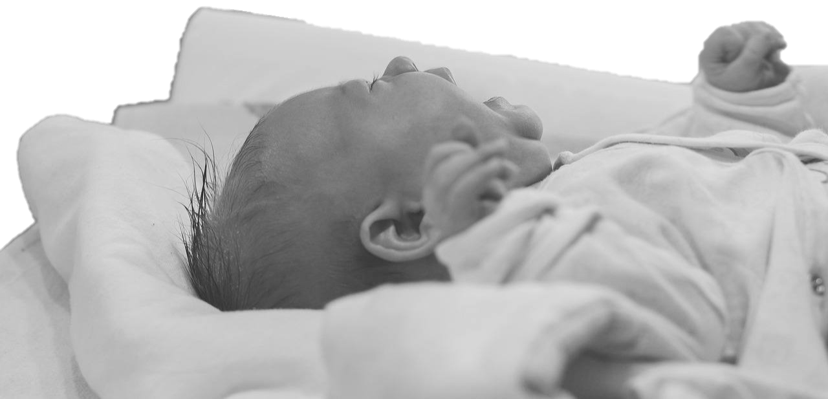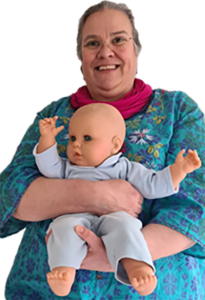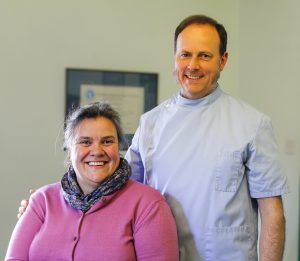
One of the hardest things to deal with when you have a young baby is their cry or even screaming. One of the reasons could be reflux or silent reflux (if you do not see milk being regurgitated). Reflux is given as a diagnosis when the stomach contents come up from the stomach along the oesophagus to the mouth. As the stomach naturally contains acid this can irritate the lining of the oesophagus causing discomfort or pain. If the reflux causes pain to the baby on a regular basis it can cause poor growth or other problems. According to NICE Guidelines reflux is common and affects four out of 10 babies younger than a year.
Czinn and Blanchard (2013) in their research found that 75% of newborns suffer regurgitate on within the first two weeks of life but almost entirely resolves without intervention by the end of the first twelve months of life.
A systematic review of 30 studies reported a worldwide prevalence of infantile colic ranging from 2–73%, with an average prevalence of about 20% in infants under 12 months of age [Vandenplas, 2015b].
 Many cases of reflux and colic could be associated with lactose intolerance, congenital diaphragmatic hernia (CDH), immature sphincter development, abnormal gastrointestinal motility, pain signals from sensitized pathways in the gut viscera, or excess gas production in the gastrointestinal tract, or possible gut inflammation and even psychosocial factors. Osteopaths consider several other etiological factors, i.e the role of the Vagus nerve and visceral afferents from the stomach, or the potential of a birth strain creating cranial and upper cervical compression and tension on the vagal nerves around the jugular foramen in the skull. Osteopaths also look at local thoracic, diaphragmatic and intestinal tension and irritation which can also result from intrauterine or birth strain, including caesarean births that do not give the baby the advantage of normal “elastic recoil” following a vaginal delivery to “unlock” the cranial bones which can be moulded even without vaginal delivery. The mechanism that explains colic is not fully understood and most likely colic aetiology is multifactorial.
Many cases of reflux and colic could be associated with lactose intolerance, congenital diaphragmatic hernia (CDH), immature sphincter development, abnormal gastrointestinal motility, pain signals from sensitized pathways in the gut viscera, or excess gas production in the gastrointestinal tract, or possible gut inflammation and even psychosocial factors. Osteopaths consider several other etiological factors, i.e the role of the Vagus nerve and visceral afferents from the stomach, or the potential of a birth strain creating cranial and upper cervical compression and tension on the vagal nerves around the jugular foramen in the skull. Osteopaths also look at local thoracic, diaphragmatic and intestinal tension and irritation which can also result from intrauterine or birth strain, including caesarean births that do not give the baby the advantage of normal “elastic recoil” following a vaginal delivery to “unlock” the cranial bones which can be moulded even without vaginal delivery. The mechanism that explains colic is not fully understood and most likely colic aetiology is multifactorial.
A baby with a tongue tie swallows more air due to its inability to maintain a good seal, this air needs to find its way out – burping or passing wind – both can result in a distended tummy and aggravate reflux. Tongue function needs to be assessed by your osteopath or lactation consultant.
Osteopaths focus on gently easing any strain patterns within cranial bones and soft tissues, cervical spine, tongue and the tempro mandibular joint(Jaw joint) etc to optimise the neural reflexes and balance the chest, diaphragm and abdomen. Often the treatment helps the baby to release any compression and torsion in the body and unwind. Osteopathy in the cranial field or more general osteopathic treatment like unwinding and releasing techniques to the chest, spinal muscles, abdomen and whole body can be employed.
In my own clinics I often divide babies with reflux into two categories ‘’Happy sickers ‘’and ‘’Non happy sickers’’. The happy sickers you can probably adjust your handling of your baby , feed smaller and more often and adopt a lie on left side when your baby is awake, and you are watching them. All babies must sleep on their backs in line with the current guidelines.
Unhappy sickers may need a slightly different approach. It would be wise to adjust your handling, making sure that you do not sit them, always bend their legs up etc. (For more information look at our websites or book a consultation.) If you are bottle feeding you may want to consult your health visitor and/or GP to help you decide if the use of a thickener is appropriate at this stage Babies with reflux can seem to want more feed and the distension of their stomach on an immature sphincter can cause the regurgitation. So perhaps smaller feeds more often might help.
If your baby has been diagnosed with reflux you are often left with two choices of medicine Baby Gaviscon or omeprazole or just a comment that your baby will grow out of it. They may be helpful but they the first one comes with a risk of making your baby constipated which then means when they strain the milk comes up via the mouth negating the effect of taking baby Gaviscon. Omeprazole again may be helpful but is quite difficult to wean your baby off when you start feeding your baby solids.
The other thing you are told to do is to keep your baby upright. However, this needs to be done in a way that does not encourage your child to:
- Extend out even more, arching their back and straightening their legs, otherwise it can perpetuate the problem rather than aid.
- Sit. Babies under 6 months of age are not designed to sit.
The alternative way would be to hold the baby in a chair position or on the tummy on your arm facing out.
Diagnosing reflux
Signs of reflux
- See milk coming up and your baby is distressed by the action.
- Regurgitate feeds very easily.
- Your baby coughs a lot
- Your baby might arch their backs pushing their head back, drawing the knees up to the abdomen and clenching their fists.
- They might fuss a lot at feed time or refuse feeds
- There are recurrent and prolonged periods of infant crying, fussing, or irritability that occur without obvious cause and cannot be prevented or resolved by caregivers.
- Your baby chokes when they are laid down
- Can be made worse by cow’s milk protein allergy so they might have a rash.
- It tends to start before the baby is 8 weeks old.
- It can disappear on its own by 1 years of age.
- There are recurrent and prolonged periods of infant crying, fussing, or irritability that occur without obvious cause and cannot be prevented or resolved by caregivers.
- There is no evidence of faltering growth, fever, or illness.
6 things you can do.
- Check with your GP that the diagnosis is reflux and not something else.
- Make sure that the milk they are on is not upsetting their digestion.
- Make sure that your baby is putting on weight by having them weighed and plotted on growth chart.
- Carry your child in the chair pose to soothe them.

- Do tummy time. It may seem counter-intuitive, but it helps to lower the diaphragm. Then the two little slips of muscle can more effectively close off the cardiac sphincter at the top of the stomach preventing seepage even when the baby brings up wind. Look at you tube channel on my website Percival Osteopaths or Smart-Growing website and the YouTube channel to see how to do tummy time safely and effectively with your baby, including a new-born.
- Get a breast-feeding assessment.
- See a paediatric trained osteopath.
- If you are breast feeding pay attention to your diet particularly milk intake, cruciferous vegetables ,onion, chocolate, and spicy foods.
- When your baby is awake, and you are watching you can place your baby lying down on their left side which has been shown to be helpful in preventing regurgitation. All babies must sleep on their backs until due to sudden infant death syndrome risk. You should put your baby to sleep on his back from birth and continue to do so until he is 1 year old. While the incidence of SIDS is highest for the first six months, the recommendation of “back to sleep” applies for the whole first year. Once baby can roll from back to stomach and from stomach to back on their own, you can leave them in the position they choose after starting sleep on their back.
4 things not to do.
Complications of colic include parent or carer stress and sleep deprivation, fatigue, loss of confidence in parenting skills, anxiety or depression, premature cessation of breastfeeding, and increased risk of child maltreatment. First, look after yourself – your own wellbeing by resting when able, accessing support, and taking ‘time out’ if needed. Please, get more information, i.e. talking to your doctor and the health visitor or pharmacist, and NICE website is also a sources of information: https://cks.nice.org.uk/topics/colic-infantile/
We encourage all caregivers to create an environment of calmness, comfort and relaxation for the baby by improving on handling skills. Good supportive handling skills will help. There are several positions that can be used to facilitate the release of gases. Do not allow your baby to sit on your lap. Babies are not meant to sit until they can get into sitting position by themselves which is sometime between 5 and 8 months of age, it will add pressure to their abdomen increasing the likelihood of regurgitation and the action of sitting will make their lower back tight sore and stiff and will add to their distress at the end of the day in that bewitching hour. Premature sitting position also compromises breathing as lungs and chest are still developing.
- Do not allow your baby to be on your shoulder with their legs dangling straight. Instead tuck their legs up.

- Try not to over feed your baby. Perhaps small and often would be better. Babies will try to feed for comfort and that could mean that they are always trying to feed and not giving their digestion time to rest in between feeds.
- Do not avoid tummy time and use side position often during the activity time
- If you are breast feeding avoid spicy food.
When to get more help.
- If the milk that comes up projects into the room and lands someway away from you. This could be projectile vomiting and you should consult a healthcare professional.
- If your baby is bringing up milk that is green or yellow or has blood in it consult a medical professional.
- If your baby is worsening and is inconsolable and will not stop crying, or if your baby stops feeding and reduced output of urine consult a doctor.
Hilary Percival and Helen Terentjev
References
Czinn SJ, Blanchard S. Gastro oesophageal reflux disease in neonates and infants: when and how to treat. Paed Drugs 2013 Feb;15(1):19-27 Pubmed
Nice guidelines – https://cks.nice.org.uk/topics/colic-infantile/
2015 Yvan Vandenplas 1, Abdelhak Abkari, Marc Bellaiche, Marc Benninga, Jean Pierre Chouraqui, FügenÇullu Çokura, Tracy Harb, Badriul Hegar, Carlos Lifschitz, Thomas Ludwig, Mohamed Miqdady, Mauro Batista de Morais, Seksit Osatakul, Silvia Salvatore, Raanan Shamir, Annamaria Staiano, Hania Szajewska, Nikhil Thapar
Prevalance and health outcomes of functional gastrointestinal symptoms in infants from birth to 12 months of age. PMID: 26308317 PMC4631121 DOI: 10.1097/MPG.0000000000000949


